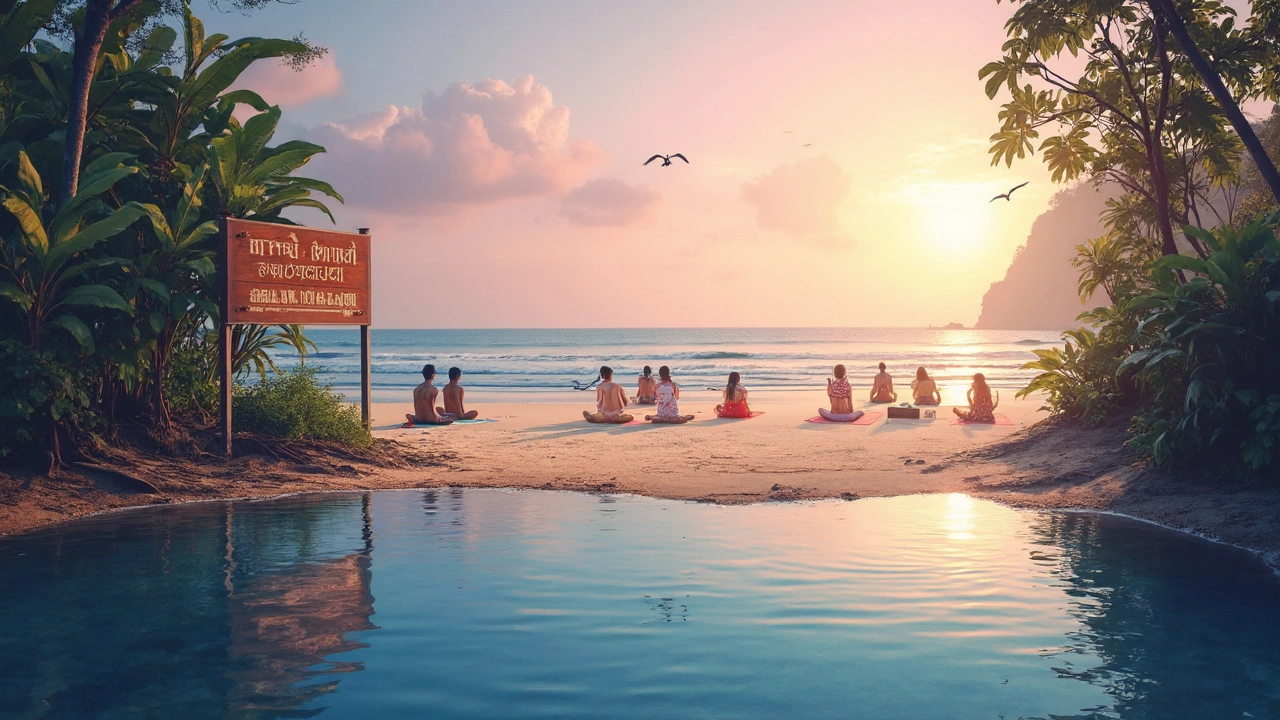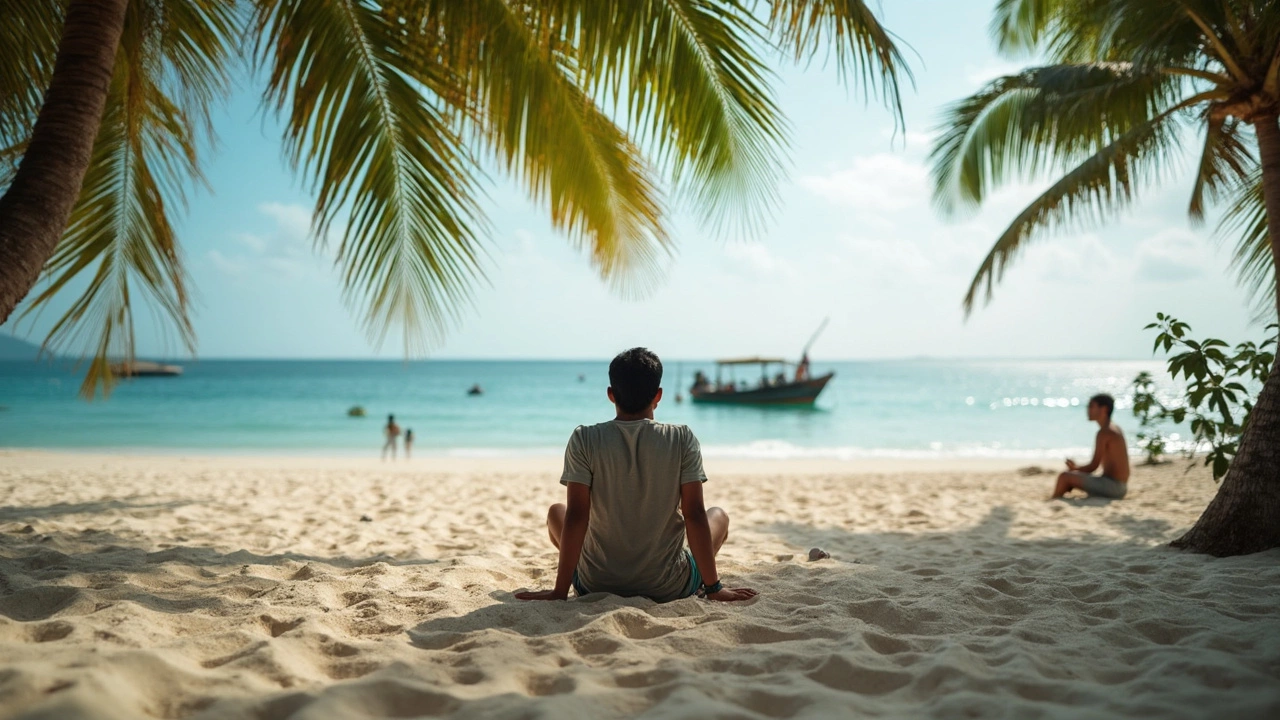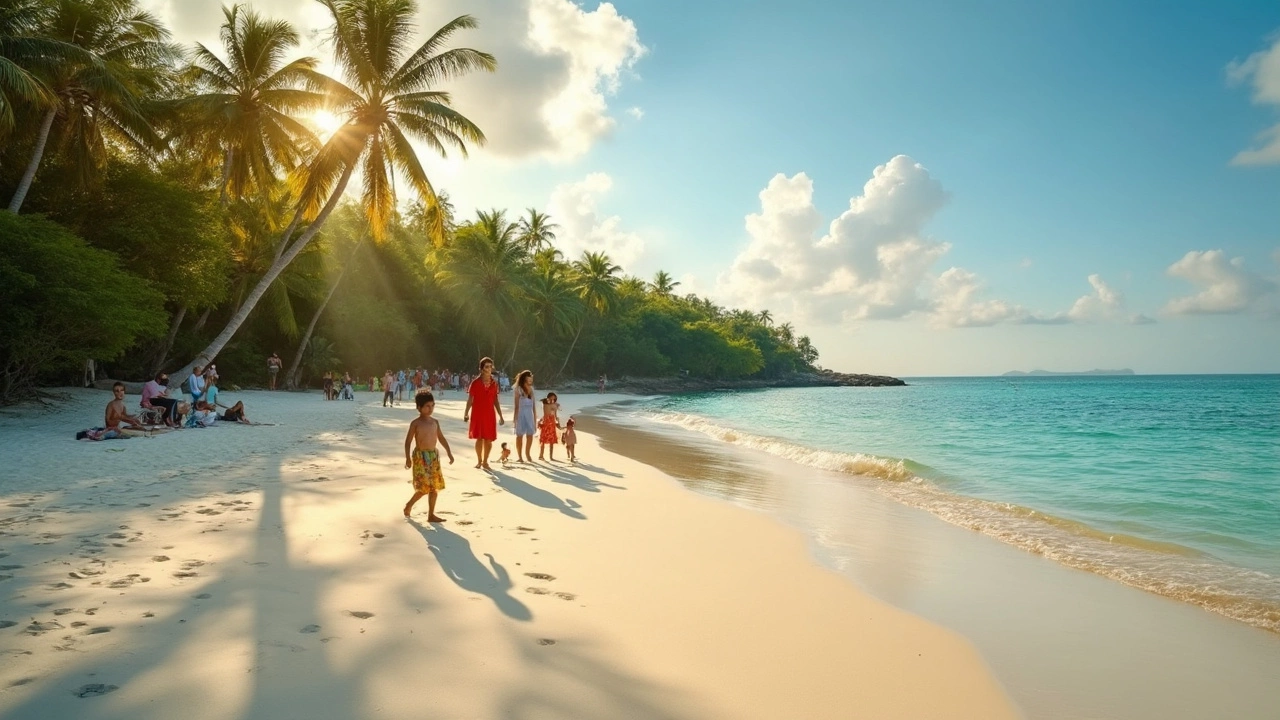Skip the debate—most travel experts and beach fanatics put Radhanagar Beach on Havelock Island, India, at the very top of their lists. We're talking about a place that Tripadvisor once called the best beach in Asia, with white sand so smooth it feels fake and water so blue you'd swear someone cranked up the saturation. But here's the kicker: Radhanagar isn't crowded with sunbeds, vendors, or water scooters zipping around. That's rare, right?
This spot is perfect if you want the real deal: the Indian Ocean lapping at your toes, palm trees overhead, and enough space to stretch out without bumping into someone's selfie stick. There's a reason its sunsets are legendary—clean horizons, uninterrupted views, and colors you'll struggle to capture on camera. Most locals will recommend going in the morning or late afternoon to dodge the heat and soak in the quiet.
If you're wondering if the trip is worth it, trust me—Radhanagar lives up to the hype. It's easy to reach by a ferry from Port Blair, and the surrounding jungle adds a wild, untouched vibe you won't get on many "famous" beaches. If you crave peace, fresh coconuts, and breathtaking views, this beach delivers all three without fuss.
- Radhanagar Beach—Why All the Hype?
- Travel Essentials: Getting There and Around
- Best Ways to Enjoy the Beach
- Local Food, Stays, and Culture
- Must-Know Tips for an Epic Visit
Radhanagar Beach—Why All the Hype?
Here’s the truth: Radhanagar Beach isn’t famous just because influencers say so. There’s some solid evidence behind the buzz. This place has racked up international awards and tons of traveler love. In 2004, Time magazine called it the best beach in Asia. Even now, it keeps popping up in those “world's best beaches” lists, often beating out beaches in places like the Maldives or Hawaii. People who visit come back and say, yeah, it’s really that good.
What sets Radhanagar apart? It’s way cleaner than most beaches, and the authorities actually care about keeping it that way. There are signs everywhere asking folks not to litter, and you’ll barely see trash lying around. The beach itself is wide, so there’s room for everyone—from families to couples to solo travelers like my friend who needed a total digital detox. The water is safe for swimming, and there are lifeguards on duty during the day.
Curious how it stacks up with other popular beaches? Here’s a quick look at real-world data:
| Feature | Radhanagar Beach | Bora Bora | Whitehaven Beach |
|---|---|---|---|
| Sand Type | White, fine, powdery | White, soft | Silica, bright white |
| Water Quality | Crystal clear, blue-green | Turquoise, clear | Aquamarine, very clear |
| Crowds | Usually light-moderate | High (peak season) | Low (remote access) |
| Lifeguards | Yes | Rarely | No |
| Sustainability | Strict policies | Moderate | Basic |
Now, here’s something you don’t hear enough about: Radhanagar feels untouched because there’s a cap on commercial development. No giant resorts or fast food chains choking the shoreline. So, you’re more likely to bump into a coconut vendor than a noisy nightclub. Shade is easy to find, thanks to a stretch of Mahua trees lining the sand, so you don’t have to worry about roasting all day.
Another bonus—sunsets here are the real deal. The angle of the beach faces exactly where the sun dips over the Andaman sea. Locals often say, "Don’t leave before sunset." And they’re right. The colors are wild, from orange to deep purple, and no two sunsets look the same. For anyone who’s after a chill spot with serious bragging rights, Radhanagar Beach is hard to beat.
- Peak season (October–April) means perfect weather with calm water and mild humidity.
- Marine life is amazing—snorkeling nearby sometimes surprises you with turtles and rays.
- No noisy water sports. The focus is pure relaxation and a bit of swimming.
If you ever needed proof that paradise doesn’t have to mean packed beaches and tourist traps, this patch of the Andamans is it. There's a reason everyone calls it the best.
Travel Essentials: Getting There and Around
Getting to Radhanagar Beach is easier than most people think, but you do need to know the drill. The first step is flying into Veer Savarkar International Airport in Port Blair, which is well-connected with direct flights from cities like Delhi, Kolkata, and Chennai. Flights usually take around 2 to 3 hours from the mainland. Go early morning if you can—the later flights sometimes get pushed because of weather.
From Port Blair, your main move is the government or private ferry to Havelock Island, now called Swaraj Dweep. The ferry ride lasts around 90 minutes, and tickets can sell out, especially in peak season (November to April), so book ahead online through official sites or local agents. Pro tip: Private ferries are a bit more expensive but have air-conditioning and cushier seats. Government ferries are cheaper and slower—it’s a trade-off.
- Arrive at Havelock (Swaraj Dweep) jetty. From there, Radhanagar Beach is about 10 kilometers away. Taxis and auto-rickshaws hang around the jetty, but costs are fixed and surprisingly fair. Make sure you agree on the price before getting in.
- Renting a scooter or bike gives you freedom to explore the rest of the island. These rentals are everywhere near the main market area and are perfect if you want to check out other cool spots without waiting on taxis.
- Buses also run between the jetty and Radhanagar, with a handful of trips daily. They’re packed and simple but super cheap.
Unlike some other famous best beach in the world contenders, you won’t find beach shacks or high-rise hotels lined up on Radhanagar’s shore. The nearest stays are set back among palm trees, just a five-minute walk away. That’s a win for peace and scenery, but it also means you’ll want to carry snacks, water, sunscreen, and maybe an umbrella for a long day out.
Don’t stress about mobile connectivity—most major Indian carriers have decent coverage around Havelock, though it can dip near dense forest areas. Cash works best for small expenses, but some places now accept digital payments too. Last thing: Ferry timings can change if the weather’s rough, so always check and confirm your ride back to Port Blair the day before you leave the island.

Best Ways to Enjoy the Beach
Radhanagar Beach isn’t just nice to look at—there’s loads to do (or not do!) if you want to really savor your day. The most popular move? Plop down right near the lifeguard tower and just chill. Most visitors rave about the sand here—it stays pretty cool even when the sun is up, so barefoot walks are a must. Don’t race for the water, though. Zero waves means it’s great for swimming, but the current can change, so keep an eye out for the flags and lifeguard signs.
Want more than a swim? Grab a snorkeling mask. You won’t see giant corals right off the shore, but you can spot small, colorful fish if you’re patient. If you like your walks with a side of major views, stroll all the way to the north or south ends of the beach—most folks gather in the middle, but at the ends you’ll find nearly empty stretches for your own private paradise moment.
After swimming or walking, find the food vendors just outside the gates (no snacks allowed on the actual beach). They're famous for fresh coconut water—exactly what you need to cool off. And don’t miss sunset. Most regulars say the best spot is the middle of the beach. The sunset there? Wild. You’ll see that deep orange sky blended right into the ocean.
- Stick to swim zones marked by flags.
- Use reef-safe sunscreen to protect the fragile water life.
- Bring your own towels and water bottles, since rentals are slim to none.
- Respect local rules—music and alcohol are a no on the sand.
Bottom line: the best beach in the world isn’t about fancy resorts or water toys. It’s about slowing down, feeling the sand, jumping in the ocean, and seeing why Radhanagar stands out even with zero hype.
Local Food, Stays, and Culture
When you’re at Radhanagar Beach, you won’t be stuck eating plain old chips or generic fast food. The area is all about fresh seafood—the daily catch is the star at most simple beachside shacks and mid-range resorts. Grilled snapper, spicy crab curry, and coconut-rich fish stew pop up on most menus. Vegetarians aren’t left out either; you’ll find local thalis loaded with island-grown veggies and tasty dal.
Unlike big party beaches, nightlife is pretty chill here. Think sunset viewpoints, local dance performances, or hanging out with travelers over a cold Kingfisher or coconut water. It’s less about clubs and more about enjoying the calm and quiet. Andaman’s mix of Bengali, South Indian, and local tribe influences shape the food and some festivals you might catch, like Subhash Mela if you visit in January (a splashy celebration that hits Havelock every year).
Finding a place to sleep isn’t a pain—there’s something for every budget. Here’s a quick look at what you’ll come across on Havelock Island:
| Type | What to Expect | Price Range (per night, INR) |
|---|---|---|
| Beach Huts | Basic rooms, fans, walkable to the beach | 800 – 2,000 |
| Resorts | Air-conditioning, private cottages, pools | 3,000 – 10,000 |
| Homestays | Local family run, simple meals, cozy vibe | 1,000 – 2,500 |
The bigger resorts, like Barefoot at Havelock or Coral Reef Resort, are closest to Radhanagar Beach and come with gear rentals and tour desks for scuba and snorkeling. If you like things more authentic (and affordable), homestays in nearby villages like Govind Nagar give a peek into island life—and the best sweet chai, in my opinion.
One thing people forget: the culture here is laid-back. You won’t get hassled. Locals are welcoming but leave you alone if that’s your thing. It’s not Goa, so rules around plastic and pollution are stricter—don’t ignore them, because the locals are serious about keeping their slice of paradise clean. Carry your own bottle, skip the plastic bags, and you’ll fit right in with the vibe and the rules.

Must-Know Tips for an Epic Visit
Before you pack your bag for Radhanagar Beach, a few key tips can make a massive difference between just another trip and an experience you’ll talk about for years. First off, bring cash. Internet is slow in most parts of Havelock, and not every place accepts cards or online payments. ATMs are limited, so grab what you need before heading to the ferry terminal at Port Blair.
If you want to enjoy that postcard-perfect vibe, try to visit between November and March. The Andaman weather is less humid, there’s hardly any rain, and the sea is usually super calm. Summer and early monsoon months (April to August) can get muggy and sometimes see unexpected rainfall.
Popular travel site Lonely Planet says it best:
“Radhanagar remains beautifully untouched by mass tourism. Arrive early, respect the natural setting, and you’ll see why it’s considered a global treasure.”
Now, about safety—strong currents sometimes sneak up, especially during high tide. The beach does have lifeguards, but always keep an eye on the red flags and listen to their advice. Don’t venture deep if you’re not a confident swimmer. There are jellyfish now and then, but most are harmless. Still, good idea to avoid the water right after heavy rain.
Pack eco-friendly sunscreen. The local government tries hard to keep Radhanagar clean and plastic-free—tourists using single-use bottles or snacks in wrappers earn some serious side-eye. There are trash bins, so use them. If you’re coming with kids, carry your own beach toys and gear. Shacks don’t rent much more than snorkels or fins.
Give yourself at least a couple of hours to unwind. Trust me, the sunset gets a crowd, but mid-morning and late afternoon are when the beach really shines for photos and chilling out. For the sunset, get your spot by 4:30 pm, especially in peak season.
No article is complete without some quick stats that matter to your trip:
| Best Months | November - March |
|---|---|
| Ferry Time From Port Blair | 1.5 - 2.5 hours |
| Crowd Levels (Peak Season) | Moderate to Busy (Sunset time) |
| Closest ATM | Havelock Island Market (about 8 km) |
| Plastic Ban | Enforced (bring your own bottles) |
- Dress light—you don’t need fancy clothes here, just flip-flops and shorts.
- Rent a scooter if you want to explore the island; auto-rickshaws are pricier for multiple hops.
- Don’t touch or move starfish, shells, or coral—it’s illegal and bad for the ecosystem.
- If you want pro-level photos, the golden hour before sunset is unbeatable for natural light.
- Bonus: Ask a local about the secret mangrove path if you like quiet nature walks.
A little planning goes a long way here. Stick to these tips, and you’ll see why so many folks rank Radhanagar as the best beach on the planet.
